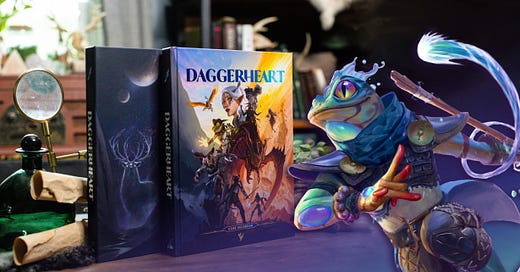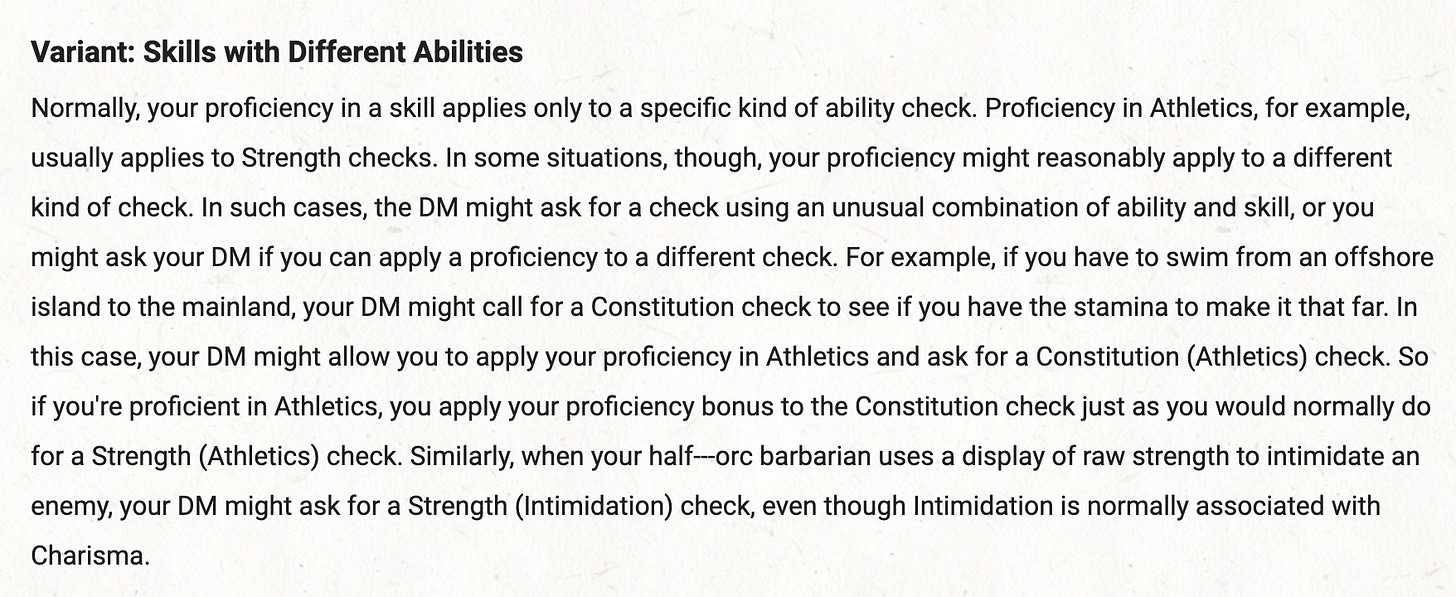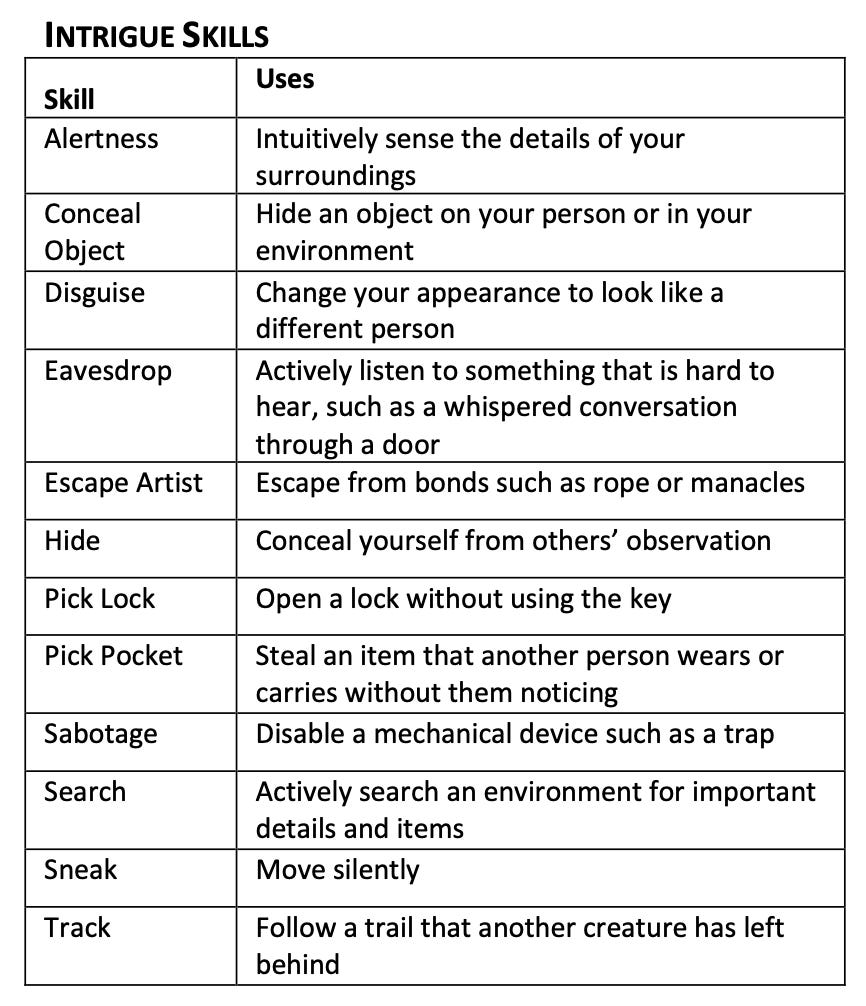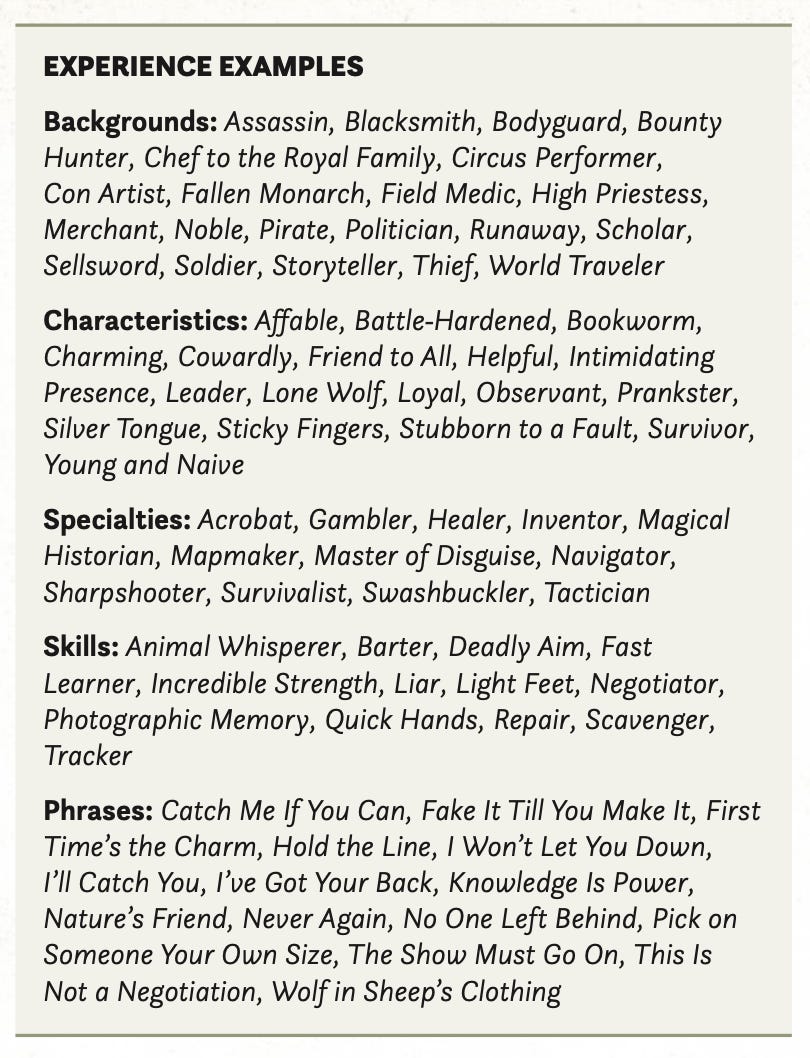Two Approaches to Skills in Heroic Fantasy TTRPGs
How Draw Steel and Daggerheart improve on 5e's skill system in two different ways
Draw Steel and Daggerheart are two games trying to do similar things. They both take the fantasy setting and heroic style of the D&D tradition and modernize the rules to better fit the games we’ve already been playing in 5e. Just like how the OSR captured specific styles of D&D with rules tailored to that experience, Draw Steel and Daggerheart are doing the same for heroic fantasy.
The ways these games innovate upon 5e manifests in their skill systems. With fairly subtle changes, they change the dynamics significantly.
I’m Colin, and I’m a professional video game designer. This is Drolleries, where I write about d&d, ttrpgs, and game design. Thoughtful articles in your inbox weekly, every Monday.
Calling for Skill Checks in 5e
In 5e, the GM calls for checks with a specific attribute and skill, and this is what’s called for in 5e’s published adventures - it’ll call for a Wisdom (Perception) check or a Charisma (Persuasion) check.
Skills in 5e are also very broad. Survival could mean following tracks, finding food in the forest, or knowing a safe path through the wilderness, which causes overlap in the skills. Because skills are so broad, players can find a way to fit nearly any roll into an existing skill.
Also, because of the math of 5e, players want to roll with their skills so they can apply their Proficiency Bonus (PB). This issue only worsens as they level up, because as the DCs increase and their PB increases, players need to keep adding their PB to checks to keep pace with increasing challenge. Player characters’ power comes from using their skills, not just their ability scores. This means that PCs are less likely to attempt something unorthodox if it doesn’t fit into one of their skills. And this pressure only increases as they level up.
Try asking a 5e fighter to make a Strength check to break open a door.
Nine times out of ten, they’ll ask if they can use Athletics.
In my personal GM opinion, that’s not really what “athletics” should mean — smashing open a door is more of a raw test of strength, it doesn’t require any of the precision or skill or… athleticism that we associate with Olympic athletes.
But as the GM, it feels punitive to not allow your fighter player to use their skill in Athletics, especially because they’re just trying to use their only useful skill, and they probably can’t contribute much to social scenes anyway.
This is the fighter’s time to shine, so just let them use the skill - but not because their skill in Athletics expresses their character or adds to the fiction - only so that they can apply their PB and keep up with the math of the system.
But we already know a character with high Strength is strong, so why must they also take proficiency in Athletics? It doesn’t establish anything new or interesting about their character, especially now that we’ve stretched the definition of what Athletics is.
So what are skills for anyway?
The Purpose of Skills
In heroic fantasy ttrpgs, the purpose of a skill system is to encourage character expression. Skills define a specific thing that a character can be extra good at, to differentiate them from other characters of their class or archetype. For example, a roguish assassin with skills in Persuasion and Deception is distinct from a roguish assassin with skills in Athletics and Intimidation.
A skill system shines when it can establish differences within a general archetype. But 5e’s skills are so broad that they lose some of their meaning. Nearly all fighters and barbarians take Athletics because it’s so broad that they can use it with nearly every Strength check, which means that a character having proficiency in Athletics doesn’t really establish anything about their character.
5e’s Variant Rule is a Half-Hearted Solution
The common fix cited online is to use the variant rule called Skills with Different Abilities. With this rule, players can apply their PB from any skill to any attribute check that might apply.
This fixes some issues by allowing players with high bonuses in certain skills to be more creative in their uses. But it doesn’t solve the problem fully. How often can you apply Strength to a Persuasion check? What about Acrobatics? The flexibility is limited, as you’re still locked into a certain number of fathomable combinations.
This is because ability scores in 5e are very specific; the stats don’t allow much room for interpretation. We all know that Charisma is for talking. No matter how hard you try to convince your GM, you can’t use Dexterity for talking. In addition to the rigidity of 5e’s ability scores, there aren’t enough skills to have unique combinations of abilities and skills.
In order to fully embrace this solution, 5e would require more skills that are more specific to encourage players to be creative with their uses.
Draw Steel: Mix-and-Match Skills and Attributes
Draw Steel is MCDM’s new fantasy ttrpg with a focus on tactical combat and heroic-level stories. It’s slated for a full release this summer, but I’ve seen playtest versions of the game and been following its development through their many devlogs.
Draw Steel uses its skill system to promote character expression while preserving the flexibility of rolling with attributes. GMs call for rolls with attributes (Might, Agility, Reason, Intuition, Presence) instead of skills, and the skills are much more numerous and specific. It’s a reversal of the expectation of 5e; in Draw Steel, you roll with your attribute 80% of the time and apply a skill 20% of the time.
For example, the Athletics skill in 5e is broken into Climb, Endurance, Gymnastics, Jump, Lift, and Swim, allowing for much more specific differences between Might-focused characters. Whereas most bards in 5e will often just pick Persuasion and Deception, a Draw Steel troubadour can choose Flirt or Brag for a more self-obsessed playboy archetype, or choose Lead and Persuade for a more inspiring leader archetype. Skills provide more opportunity for differentiating characters within each class.
Math-wise, skills only give you a small bump to your rolls (+2 on a 2d10 roll, where your best stat is a +2 at level 1), and the progression happens mainly with your attributes, not your skill bonus. This means there’s less pressure to only roll when your skills apply. If you’re a Might-focused character trying to climb a mountain and you don’t have the Climb skill, it’s no big deal - you still have a good chance of success.
Because of the naming of the attributes and the specificity of the skills, Draw Steel also enables more mixing and matching of attributes and skills. Interpersonal skills like Lie or Flirt can be used with Reason, Intuition, or Presence depending on the character, and intrigue skills like Disguise, Escape Artist, Hide, or Track could be applied to physical or mental skills depending on the scenario.
Players can be more creative with their actions, as opposed to ensuring that every action must conform to a few broad sets of actions. Skills in Draw Steel are tools for character expression, and aren’t necessary (or expected) for players to achieve success.
Daggerheart: Freeform Character Skills
Daggerheart is a heroic fantasy ttrpg by Critical Role that focuses on collaborative narrative play, and as such, its skill system is much more freeform. During the beta playtest, I ran a 3-session arc for 6 players, and we all fell in love.
Daggerheart doesn’t have a set list of skills. Instead, each character has a number of experiences defined by the player. When you do something that invokes one of your experiences, you can spend 1 hope to gain +2 on your roll of 2d12 + an attribute.
Players’ experiences can be anything they want, within reason. As the rulebook says, other than writing “Talented” or “Focused,” your experiences can be quite broad, even broader than 5e. But it doesn’t create the same issues because characters of the same archetype can always be differentiated. Not all fighters or barbarians will have Athletics — one can have the experiences Gladiator and Survivalist and the other can have Never Back Down and Unseen Predator, codifying the difference between these two characters with the skill system.
Also, because players have to spend hope to gain the benefits of an experience, the usefulness of a broad experience is limited. The character with Gladiator isn’t always more powerful than the one with Never Back Down, because they both have a cost to be used.
The downside of players writing their own experiences is that balancing usefulness and flavorful-ness can be difficult, especially for new players. It took a lot of coaching by me to help my players write a set of good experiences that could come up during play, but also showcase their characters’ unique personalities and backgrounds.
In my game, the troubadour player had Musician, Swashbuckler, and Pirate, while the rogue player had The Finer Things In Life, I Challenge You To A Duel!, and Mi Amor (Gently Kisses Hand). Both players had fun, but the second character’s personality was expressed more strongly in the mechanics. This made it clear to me that there’s a degree of player skill in writing good experiences that are both flavorful and mechanically useful.
This wasn’t necessarily a problem, but I think with some more guidance, all my players could indulge in the fun of ultra-flavorful experiences while still being useful…
How I Would Run Experiences
I really liked this free-form way to incorporate player expression without a rigid skill system, but I think it could benefit from a bit more structure.
When I next run Daggerheart, I may suggest players make sure each of their experiences answers one of the following questions, with no repeats. The goal is to ensure that every player has experiences that are useful, flavorful, and showcase their character.
Background. What did you used to do before becoming a hero?
Skill. What area of expertise do you have? How did you learn this skill?
Method. What’s your unique way of solving problems? How do you approach difficult situations?
Ideal. What do you believe about the world or other people?
Purpose. Why did you become a hero? How do you want to change the world?
I’m really excited to run the final version of Daggerheart. My physical edition just arrived, so I’m looking forward to playing in-person with all the cards and dice and tokens.
Thanks for reading! Subscribe to get notified about future articles!









The problem with skills vs stat checks! It is two mechanics solving the same problem, clumsily coexisting. Designers have patched this split a dozen different ways over the past two decades. But since D&D is main way people get into the hobby, we keep reinventing the same fixes
There’s a lot here that can be used to open up a system that has no stats and relies on skills.
It reminds me of the backgrounds in Barbarians of Lemuria. A character can have, I think, up to three backgrounds. If the player takes the same one three times they are masters at anything that can be done by that career. It makes them specialized while leaving how they apply their experience up to interpretation. A player could choose two of one background and one of another, or even three different ones. It depends on the concept and if the player wants to trade higher skill for broader knowledge.